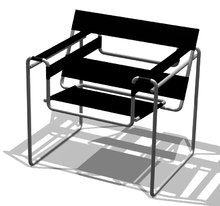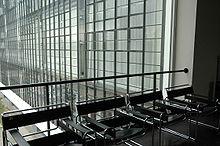- Wassily Chair
-
Wassily chairs in the Bauhaus of Dessau

The Wassily Chair, also known as the Model B3 chair, was designed by Marcel Breuer in 1925-1926 while he was the head of the cabinet-making workshop at the Bauhaus, in Dessau, Germany. Despite popular belief, the chair was not designed for the non-objective painter Wassily Kandinsky, who was concurrently on the Bauhaus faculty. However, Kandinsky had admired the completed design, and Breuer fabricated a duplicate for Kandinsky's personal quarters. The chair became known as "Wassily" decades later, when it was re-released by an Italian manufacturer named Gavina who had learned of the anecdotal Kandinsky connection in the course of its research on the chair's origins.
The chair later known as the "Wassily" was first manufactured in the late 1920s by Thonet, the German-Austrian furniture manufacturer most known for its bent-wood chair designs, under the name Model B3. It was first available in both a folding and a non-folding versions. In this early iteration, the straps were made of fabric, pulled taut on the reverse side with the use of springs. Black and white fabric were available, as well as a popular wire-mesh fabric version. The Thonet produced version of the chair is most rare, and went out of production during World War II.
Most of Breuer's early designs were produced under license by the Berlin based manufacturer, Standard-Möbel, Lengyel & Company. The Wassily chair was the only significant early Breuer design not offered by Standard-Möbel, Lengyel & Co.
After the War years, Gavina picked up the license for the Wassily, along with the Breuer designs previously sold by Standard-Möbel, Lengyel & Co., and introduced the more recognized Wassily version that replaced the fabric with black leather straps, though the fabric version was still made available. In 1968 Knoll (company) bought the Gavina Group of Bologna. This brought all of Breuer's design into the Knoll catalog.
This chair was revolutionary in the use of the materials (bent tubular steel and canvas) and methods of manufacturing. It is said that the handlebar of Breuer's 'Adler' bicycle inspired him to use steel tubing to build the chair, and it proved to be an appropriate material because it was available in quantity. The design (and all subsequent steel tubing furniture) was technologically feasible only because the German steel manufacturer Mannesmann had recently perfected a process for making seamless steel tubing. Previously, steel tubing had a welded seam, which would collapse when the tubing was bent.
The Wassily chair, like many other designs of the modernist movement, has been mass-produced since the late 1920s, and continuously in production since the 1950s. A design classic is still available today. Though patent designs are expired, the trademark name rights to the design are owned by Knoll of New York City. Reproductions are produced around the world by other manufacturers, who market the product under different names.
References
Categories:- Chairs
- Wassily Kandinsky
- Marcel Breuer buildings
Wikimedia Foundation. 2010.


